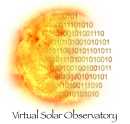Observing Time
Observing time is by general consensus the most likely parameter to be used as a first case for searches, the most ubiquitous indexing parameter for data, and one on which there is widespread agreement and understanding of representations, scales, and units. Most of the complexity involved is in the descriptions of data translation. Here it is sufficient to specify a simple uniform description.
(Most observational data are expected to be associated with observing times, and so far all VSO query structures have been assumed to include a time search parameter. It is possible however that some data may not be; model data are an example. As described above, such data would automatically satisfy any time interval query, and at least one additional parameter would be required to make them selectable.)
Observation_Time
type: time
FITS keyword: T_OBS
The time at which the data comprising an atomic data set were originally
recorded. If the duration of the data in the atomic data unit is large compared with the search time resolution, the Observation_Time is to be understood to correspond to the center (mid-point) of the observation(s), weighted as appropriate. For purposes of the Data Model, Observation_Time is given in calendar-clock form, e.g.2004.03.08_16:25. Times are assumed to be UTC. The time resolution is one minute, so for much data the conversion from say start time of an exposure to Observing_Time should not matter. Likewise the conversions between UTC and other units such as ET, TAI, and GPS should not be a matter of much concern. A data match is assumed to include all data from 30 seconds before the target time to 30 seconds after, inclusive (closed at both ends), so that a data Observation_Time can in principle fall into two adjacent target times. Note that since Jan 1, 1999, TAI = UTC + 32 sec, and GPS = UTC + 13 sec.
Duration
type: number
unit: second
FITS keyword: T_LENGTH
The interval between the start and end of observation in the atomic
data unit. For a single image or spectrum, this is simply the exposure time; for a movie, it is the time difference between the start of the first image and the end of the last.
Time_Step
type: number
unit: second
FITS keyword: T_STEP
The interval between succesive time samples (data records) in a dataset.
